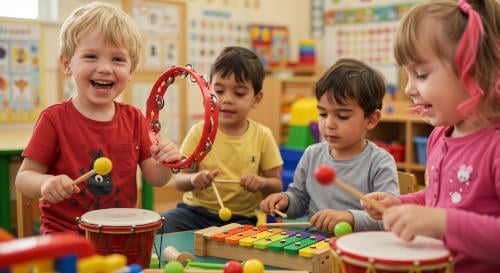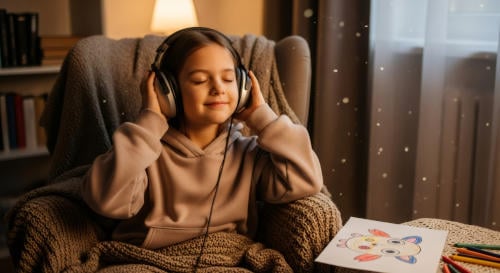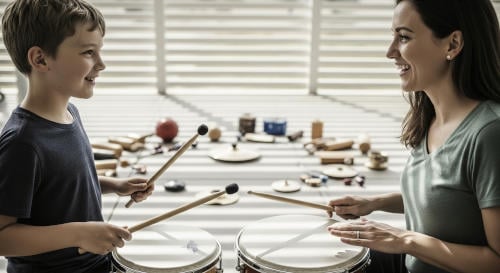There is an array of therapies open to autistic children that can have a significant impact on their life skills. Having autism can be difficult when it comes to certain abilities that some of the neurotypical community may take for granted, such as socially interacting and reading social cues.
One such treatment is music therapy, using the power of music to release possibilities to help an autistic child develop their full potential.
Mental health social network, Psych Central states that, “Music therapy can help some autistic people communicate, connect socially, and express themselves – and make great music, too.” https://psychcentral.com/autism/music-therapy-for-autism
What is the Power of Music as a Therapy?

Music provides solace and comfort for people far and wide. With its reassuring sounds, tunes and beats, it can offer security, joy and relaxation, offering a melodic routine that can bring a sense of order and expectation in a life that may sometimes seem very disordered.
Connecting with others can be a hard experience in an autistic world. Some children particularly endure verbal challenges, finding it a struggle to access any means of communication.
Music can present itself as a way through some of these obstacles, allowing communication to flourish. Through notes, rhythm and a beat, it is possible to find a way to connect, fostering the development of previously seemingly impossible accomplishments such as listening to others, understanding gestures and responding appropriately.
Music therapy can offer an autistic child comfort and relief as they seek a way into a society that sometimes feels alienating. By making music in a group, children can learn to listen, respond and finally belong. As a result, they can connect with their surroundings and the people within it, developing friendships and a deeper understanding of others.
An All-Inclusive Approach; Promoting Mental Health

Music presents its own exclusive means of communication, allowing additional opportunities for emotional development. This alternative route is all-inclusive and universal; there are no exclusions.
Nearly all children can connect in their own way to a melodic language that can offer a deeper understanding of their emotive world. It also reinforces the use of motor skills and coordination, boosting confidence and fostering a more self-sufficient and comfortable sensory existence, in turn promoting mental health and wellness.
Autism can bring difficulties with regulation in an environment that can present itself as chaotic, noisy and unrelatable. Regular musical sounds and patterns can bring some sensory stability and lift a person’s psychological well-being. Music can be soothing and calming, inducing a feeling a sense of belonging and security.
SENsational Tutors – Melissa and Nicola: Helping Autistic Children Learn and Connect Through Music

SEN tutor Melissa has used music therapy as a tutor, and Nicola has also integrated music into her work with autistic children. They both offer very encouraging feedback.
Joe, aged 10, has autism and PDA. Melissa used music therapy to develop his social communication and understanding of his emotions, in particular, anger. She explains, “At home, he was facing some difficulties, so the sessions focused on expressing himself through music rather than verbally and developing a relationship with another adult. He expressed emotions via playing instruments and songs with referenced family themes, e.g. the “Bluey and Bingo” theme.
“It was very powerful. After 10 sessions, he could take turns using musical interactions, reflect on his emotions after playing songs and use the relationship he built with me to build relationships with others.”
Nicola works with autistic children and incorporates music into their learning experience. Santi, aged 8, attends a special school. Sessions focus on developing meaningful interactions, shared attention, and social communication skills in a way that feels natural and engaging for him.
“We follow a clear and consistent structure, beginning with a hello song and concluding with a goodbye song”, Nicola states. “These familiar musical cues serve as auditory anchors, helping to orient him in time and space, and providing a sense of safety and predictability that supports his readiness to engage.
“Engagement and enjoyment are central; I maintain his attention with familiar tunes and may then, when appropriate, add in elements of academic learning – such as counting or spelling, using rhythm and melody to make these concepts more accessible and memorable.
“I might mirror his vocalisations, matching his energy through rhythm or movement, or building a shared musical story from a sound or gesture he initiates. Music becomes not just a teaching tool but a bridge for connection and co-regulation.”
Melissa and Nicola display how music offers a rich, multi-sensory learning experience, particularly powerful for autistic children. Songs incorporating gesture can help reinforce motor skills, while exploring instruments allows for sensory engagement with sound and rhythm. These experiences can invite spontaneous expression and foster confidence in a non-verbal, playful way.
Nicola concludes that, “Over time, students can show remarkable growth in their ability to initiate and sustain meaningful interactions, expressing themselves through sound and movement, remaining engaged in shared activities.”
Music therapy can serve as a powerful tool through which children can explore connection, learning, and self-expression. To find out more about how this type of approach could help a child with autism, please follow our links below.
Useful Websites:
https://psychcentral.com/autism/music-therapy-for-autism#what-is-music-therapy
https://www.bamt.org/music-therapy/what-is-music-therapy/autistic-spectrum-conditions
https://www.bamt.org/
https://www.psychologytoday.com/gb



